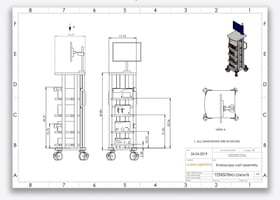Ready to make your products truly configurable with Tacton Works? You've landed in the perfect...
Tour of Tacton Works: Understanding Basics and Setting Up Your Part Structure
Did you know the key to unlocking a world of dynamic product configurations lies in an intuitive tool called Tacton Works - or nowadays Tacton Design Automation?
If you're keen on exploring this tool's capabilities, you've stumbled upon the right guide! In this series, we're going on an insightful journey through the powerful features of Tacton Works, a proven configurator that's shaking up the CPQ landscape. And to kick things off, we’re taking a deep dive into its most fundamental aspects – understanding the basics and setting up your part structure.
Tacton Works/Design Automation, part of the renowned Tacton CPQ software, offers a unique solution for product configuration that harnesses the power of good old fashion AI to manage complex products.
But how does it do it?
To answer this, let's first understand the part structure, a key component of any product configuration in Tacton Works.
Understanding the Basics
At its core, Tacton Works operates around the concept of a "Part Structure". This structure is a hierarchical representation of the components that make up your product. Each part in this hierarchy is like a building block of the product, complete with properties like dimensions, material, and other relevant characteristics.
The structure follows a parent-child relationship, where each part can have one parent part and one or more child parts.
For example, consider a bicycle. The entire bike can be a parent part, and its components like the frame, wheels, and handlebars are the child parts. This hierarchy simplifies product management and allows for deep customization at every level.
Setting Up Your Part Structure
Setting up your part structure in Tacton Works is as intuitive as it is essential. To create a part, you specify its name, type, and properties. Then you can arrange these parts into a hierarchical structure based on their relationships.
For instance, let's take a simple product – a pallet. The pallet is our parent part and it can have child parts like deck boards, stringers, and blocks. These child parts can also have properties of their own, such as dimensions (width, height, length) and state (active or inactive).
The "state" attribute can play a crucial role in the configurability of the part structure. By setting a part's state to active or inactive, you can control whether that part is currently included in the configuration or not. This lends a dynamic quality to the product configurations and is one of the powerful features of Tacton Works.
With these fundamental principles in mind, setting up a part structure becomes a breeze, and you're well on your way to creating powerful and dynamic product configurations.
Wrapping Up
As we wrap up our first dive into Tacton Works, keep in mind that understanding and setting up a part structure is just the tip of the iceberg. In our next post, we'll take our understanding further by delving into how you can make your product truly configurable by leveraging constraints. So, stay tuned as we continue to unravel the capabilities of Tacton Works.
Until then, happy configuring!



